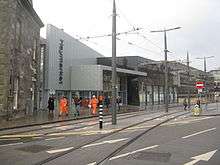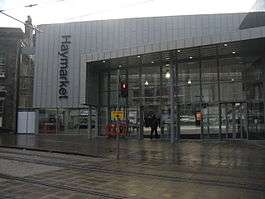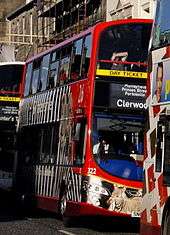Haymarket railway station
| Haymarket | |
|---|---|
| Scottish Gaelic: Margadh an Fheòir | |
|
New entrance to Haymarket railway station. | |
| Location | |
| Place | Haymarket, Edinburgh |
| Local authority | City of Edinburgh |
| Coordinates | 55°56′43″N 3°13′07″W / 55.9453°N 3.2187°WCoordinates: 55°56′43″N 3°13′07″W / 55.9453°N 3.2187°W |
| Grid reference | NT239731 |
| Operations | |
| Station code | HYM |
| Managed by | Abellio ScotRail |
| Owned by | Network Rail |
| Number of platforms | 5 |
|
Live arrivals/departures, station information and onward connections from National Rail Enquiries | |
| Annual rail passenger usage* | |
| 2010/11 |
|
| – Interchange |
|
| 2011/12 |
|
| – Interchange |
|
| 2012/13 |
|
| – Interchange |
|
| 2013/14 |
|
| – Interchange |
|
| 2014/15 |
|
| – Interchange |
|
| History | |
| Key dates | Opened 1842 |
| National Rail – UK railway stations | |
| * Annual estimated passenger usage based on sales of tickets in stated financial year(s) which end or originate at Haymarket from Office of Rail and Road statistics. Methodology may vary year on year. | |
|
| |
Haymarket railway station is the second largest railway station in Edinburgh, Scotland, after Waverley railway station.[1] It is a major commuter and long-distance destination, located near the city centre, in the West End. Trains from the station serve much of Scotland, including Fife and Glasgow, as well as suburban lines to the east, and the East Coast Main Line through to London King's Cross. It is the eighth busiest railway station in Scotland.[2]
History
The station opened in 1842 as the original terminus of the Edinburgh and Glasgow Railway, before the line was extended in 1846 through the Haymarket tunnels and Princes Street Gardens to what is now Waverley station. Its name has always been just 'Haymarket', as opposed to 'Edinburgh Haymarket' - although the latter designation is used in timetables by some train operating companies for the purpose of clarity. Covered platforms were added in 1894 by the engineer James Carswell[3] The connecting line to Slateford now used by services towards Glasgow Central and the West Coast Main Line was originally constructed in 1853 by the Caledonian Railway but lay disused for more than a century due to a disagreement over running rights with the E&GR and its successors - it was finally commissioned in September 1964 by British Rail to allow the closure of the former C.R terminus at Princes Street the following year.[4]
In 1989, the south tunnel was electrified by British Rail, and Platform 4 was extended as part of the East Coast Main Line electrification project to allow through electric trains from King's Cross in London to Glasgow Central railway station, and from Waverley station to the West Coast Main Line. In 2011, in conjunction with the Airdrie to Bathgate project, the north tunnel was also electrified.
The station has four through platforms and, since December 2006, one bay platform on the north side of the station.[5] As a general rule, trains to and from stations across the Forth Bridge use Platforms 1 and 2, with trains to and from Glasgow and the West Coast Main Line using Platforms 3 and 4. The bay platform (Platform 0) was built for services terminating at Haymarket while major engineering works were taking place at Waverley station. All platforms are electrified.

The station was listed amongst the most congested on the Scottish railway network due to rapid increases in passenger numbers. Network Rail has recently completed a £24M upgrade following the 2007 business plan, which suggested that options for remodelling passenger facilities at the station were to be considered during the period of the plan.[6] The installation of passenger lifts was scheduled to be completed by December 2010; all platforms would then become fully accessible to those with reduced mobility.[7] A new concourse, and other improvements to the capacity of the station as part of the Edinburgh to Glasgow Improvement Programme, were completed in December 2013.[8]
Haymarket TMD, a service and maintenance depot, is located 0.6 miles (1 km) west of the station, on the north side of the railway, adjacent to Murrayfield Stadium.
Accidents and incidents
- On 28 July 1924, a passenger train overran signals and was in collision with another at the station. Five people were killed.[9]
Transport interchange

The railway station is served by Edinburgh Trams service, which began operating in May 2014.[10] Renovations to station, in compliance with the Edinburgh to Glasgow Improvement Programme, have turned it into an intermodal transport interchange, whereby it is simple to connect between the trams, Lothian Buses, National Rail and taxi services.[11]
Services
References
- ↑ Every train station in Britain listed and mapped: find out how busy each one is - The Guardian
- ↑ "Station Usage Estimate 13-14". Office for Rail Regulation. December 2014. Retrieved 28 December 2014.
- ↑ http://www.scottisharchitects.org.uk/architect_full.php?id=100260
- ↑ "Railscot - Edinburgh Station and Branches (Caledonian Railway)"Railscot; Retrieved 1 July 2016
- ↑ "Train platforms open at stations". BBC News. 2006-12-27. Retrieved 2010-01-05.
- ↑ "Business Plan 2007". Network Rail.
- ↑ Dalton, Alastair (2 March 2010). "£1.5m lift as Haymarket revamp set to finish early". The Scotsman. Johnston Publishing. Retrieved 6 April 2010.
- ↑ "Haymarket Station officially opened by Transport Minister". BBC News. BBC. 19 December 2013. Retrieved 24 December 2013.
- ↑ Hall, Stanley (1990). The Railway Detectives. London: Ian Allan. p. 84. ISBN 0 7110 1929 0.
- ↑ "Revamped Haymarket railway station opens tomorrow". The Scotsman. 18 December 2013. Retrieved 17 February 2014.
- ↑ "Network Rail - Haymarket railway station redevelopment". Network Rail. Retrieved 17 February 2014.
External links
![]() Media related to Haymarket railway station at Wikimedia Commons
Media related to Haymarket railway station at Wikimedia Commons


